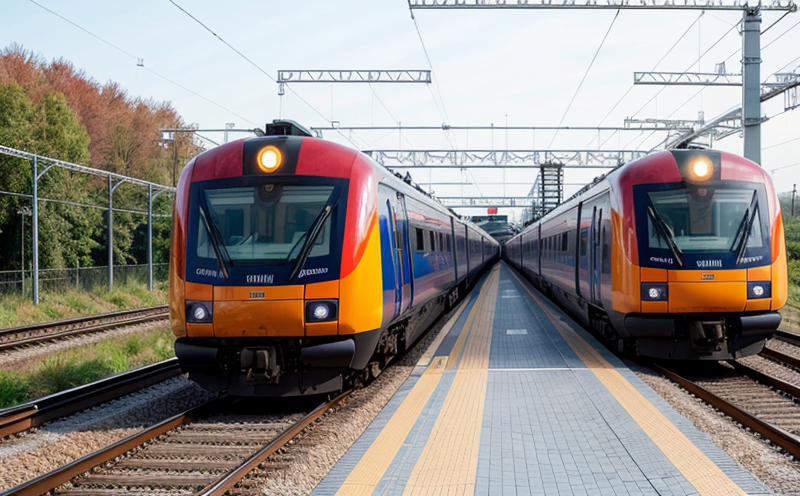EN 50126 RAMS Testing of Smart Railway Systems
The EN 50126 series of standards provides a framework for assessing the Reliability, Availability, Maintainability and Safety (RAMS) of railway systems. The scope specifically tailored by EN 50126:2023 encompasses smart railway systems that leverage advanced technology to enhance performance, safety, and efficiency.
RAMS testing is crucial for ensuring the robustness and resilience of such systems in the face of increasing complexity. In the context of smart railways, this involves evaluating not just the hardware but also software components, communication protocols, and integration with other systems. The standards address a wide range of scenarios including operational safety, fault tolerance, and recoverability under adverse conditions.
The methodology for EN 50126 RAMS testing involves several key steps:
- Initial Assessment: Identification of system risks through a detailed analysis of potential failure modes.
- Risk Analysis: Quantification and prioritization of identified risks using statistical techniques and fault trees.
- Testing Protocols: Implementation of tests designed to evaluate the resilience, reliability, and safety under various operational conditions. This includes stress testing in simulated environments that mimic real-world scenarios such as heavy traffic, adverse weather, or system upgrades.
- Data Collection: Continuous monitoring and recording of performance metrics during test phases to gather insights into system behavior.
- Analytical Evaluation: Interpretation of collected data against predefined acceptance criteria. This step often involves the use of advanced analytical tools and machine learning algorithms to predict potential failures and optimize maintenance schedules.
The testing process is designed not only to identify weaknesses but also to provide actionable insights for enhancing system reliability. For instance, in the case of smart railway systems, the test results might reveal vulnerabilities in communication protocols or suggest optimal placement of sensors for enhanced safety measures.
Compliance with EN 50126 is essential not only to meet regulatory requirements but also to ensure a high standard of safety and performance. This aligns with the broader objectives of smart railway systems, which aim to improve travel experience, reduce operational costs, and enhance sustainability.
The environmental impact of transportation systems is a critical consideration in modern railway design. Smart systems are increasingly designed to minimize energy consumption and emissions. By adhering to EN 50126 testing protocols, railway operators can ensure that their systems not only meet safety standards but also contribute positively to environmental sustainability.
In conclusion, EN 50126 RAMS testing of smart railway systems is a multifaceted process aimed at ensuring the highest levels of reliability and safety. It plays a pivotal role in the development and maintenance of advanced railway infrastructure, contributing significantly to both operational efficiency and passenger safety.
Benefits
The benefits of complying with EN 50126 RAMS testing for smart railways are manifold. Firstly, it ensures that the systems meet stringent international standards, thereby enhancing credibility and trust among stakeholders including passengers, regulators, and investors.
Secondly, by identifying potential failure points early in the development cycle, the process helps in optimizing system design and reducing lifecycle costs through targeted maintenance strategies. This proactive approach minimizes unexpected failures and associated downtime, leading to improved operational efficiency.
Thirdly, RAMS testing contributes significantly to safety enhancement. The rigorous evaluation of reliability, availability, maintainability, and safety ensures that smart railway systems can operate safely under a wide range of conditions. This is particularly important given the increasing complexity of these systems and the critical role they play in modern transportation networks.
Moreover, compliance with EN 50126 fosters innovation by providing a structured framework for continuous improvement. Railway operators can leverage test results to refine system components and develop new technologies that enhance performance and reliability further.
The environmental benefits are also significant. By ensuring robust systems, the process helps in reducing waste and optimizing resource usage. Smart railways equipped with reliable and efficient systems can operate more sustainably, contributing positively to global efforts towards sustainability.
Quality and Reliability Assurance
The quality and reliability assurance processes associated with EN 50126 RAMS testing are comprehensive and multi-faceted. Quality management in this context involves the systematic planning, implementation, and control of all activities related to railway system development.
A key aspect is compliance with international standards such as ISO 9001. This ensures that quality assurance processes are consistent and repeatable, leading to high-quality outputs. The testing process itself adheres strictly to these guidelines, ensuring that all tests are conducted under controlled conditions.
Reliability assurance is achieved through rigorous risk assessments and continuous monitoring of system performance. By identifying potential risks early in the development cycle, operators can implement targeted measures to mitigate them. This includes regular maintenance schedules and updates based on test results.
The process also emphasizes the importance of documentation. Detailed records are kept throughout the testing phase, including initial assessments, risk analysis reports, test protocols, data collection logs, and final evaluations. These documents serve as valuable resources for future reference and continuous improvement.
Finally, compliance with EN 50126 ensures that railway systems meet the highest standards of reliability and safety. This not only enhances operational efficiency but also builds trust among stakeholders, including passengers and regulatory bodies.
Environmental and Sustainability Contributions
- Emission Reduction: By ensuring reliable operation, smart railway systems can operate more efficiently, reducing the need for frequent maintenance interventions. This leads to lower emissions from idling engines or standby systems.
- Resource Optimization: Reliable systems minimize waste and optimize resource usage through efficient design and management practices.
- Natural Resource Conservation: Smart railway systems can be designed with a focus on energy conservation, which helps in preserving natural resources over the long term.
- Energy Efficiency: The testing process ensures that smart railways are optimized for energy efficiency, reducing overall carbon footprints.
The environmental benefits of EN 50126 RAMS testing extend beyond the immediate operation of railway systems. By promoting sustainable practices and technologies, these tests contribute to a greener future in transportation.





